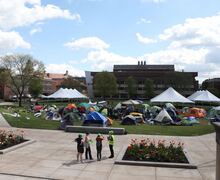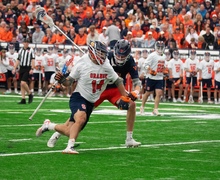I stood up to the president to defend Black lives
Courtesy Olivia Troilo
Picture this: There are dozens of folks in masks lined up along the main street of Tulsa, Oklahoma. Despite being dehydrated and covered in sweat, they’re standing on the sidewalk across from a skinny line of sunburnt people wearing red hats with white letters.
In unison, the masked people shout “Black Lives Matter.” The red hats respond in unorganized, chaotic discord with phrases such as “Make America Great Again,” “All Lives Matter,” and “protect and serve.” The people along the other side of the street show off handpainted pieces of cardboard with slogans such as “ACAB” and “no justice, no peace.”
The masked crowd is scared but angry because the rally across the street feels intimately disrespectful. President Donald Trump has chosen to host a rally less than a mile away from the Greenwood District, the site of the deadliest incident of racial violence in the history of the United States. The air still smells like soot and blood, even 99 years later. The tension along the road never eases, and the standoff only ends as news spreads along both sides of the street: “Donald Trump has arrived. The rally will start soon.”
Trump coming to Tulsa was personal. He invited white supremacists to an area right across the way from historic Black Wall Street, about two miles away from where a white police officer murdered Terrence Crutcher in 2017. Tulsans like me watched as the wheels of Trump’s motorcade traveled over sites where Black families were separated, Black businesses were burned and Black communities were eradicated nearly a century before, knowing that none of those families had received reparations or peace of mind. In choosing to hold a rally in Tulsa, 45 had joined the generations of white leaders that were complicit in the Tulsa Race Massacre.
The Supreme Red Hat had shown disregard for Black lives online and in policy decisions before, but there was something about his arrogance leading up to the June 20 clambake that felt especially taunting. A couple of nights before the rally, he tweeted that protesters in Tulsa would be met with violence, and yet thousands attended the city’s Juneteenth celebration and various downtown protests that had formed in response to his rally. Protesters countered all the swirling hatred and bigotry that entered the city limits when he arrived by showing up in legions to defend the city still healing from old wounds.
Those feelings of outrage and disgust and fear that we were experiencing earlier in the day completely dissolved as we retreated to Greenwood and celebrated the community of Tulsans who had shown up for the Black Lives Matter rally. There was music and dancing and rejoicing as the news came that barely anyone had shown up for Trump’s coronavirus-catching celebration. At that moment, it didn’t feel like we were a small group of leftists in a red state; it felt like we had sabotaged the most powerful man in the world and there was nothing he could do about it.
The next morning, I opened up Twitter to a video of Trump looking sweaty, defeated and exhausted. Tulsa had given Trump the biggest middle finger that he had seen on the campaign trail, and I am proud to have participated in it.
Olivia Troilo
Political Science, Citizenship & Civic Engagement, ‘23
Published on August 23, 2020 at 9:57 pm




